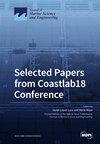Unleashing the Potential of the 360° Baited Remote Underwater Video System (BRUVS): An Innovative Design for Complex Habitats
IF 2.7
3区 地球科学
Q1 ENGINEERING, MARINE
引用次数: 0
Abstract
Coastal ecosystems are vital for numerous demersal and benthopelagic species, offering critical habitats throughout their life cycles. Effective monitoring of these species in complex coastal environments is essential, yet traditional survey methodologies are often impractical due to environmental constraints like strong currents and high wave regimes. This study introduces a new cost-effective Baited Remote Underwater Video System (BRUVS) design featuring a vertical structure and 360° cameras developed to overcome limitations of traditional BRUVS, such as system anchoring, overturning, and restricted frame view. The new design was compared against a previous one used on the northwest Iberian coast. Key performance metrics included species detection, habitat identification, and operational efficiency under complex hydrodynamic conditions. Findings reveal that the two designs can effectively identify the common species typically observed in the study area. However, the new design outperformed the previous by significantly reducing equipment losses and anchoring issues. This enhancement in field operations’ simplicity, operability, portability, and resiliency underscores the new system’s potential as a cost-effective and efficient tool for demersal and benthopelagic ecological surveys in challenging coastal seascapes. This innovative BRUVS design offers advanced monitoring solutions, improving habitat assessment accuracy and responsiveness.释放 360° 有饵远程水下视频系统 (BRUVS) 的潜力:针对复杂生境的创新设计
沿岸生态系统对众多底栖和底层物种至关重要,是它们整个生命周期的重要栖息地。在复杂的沿岸环境中对这些物种进行有效监测至关重要,但由于强流和大浪等环境限制,传统的调查方法往往不切实际。本研究介绍了一种新的经济高效的有饵遥控水下视频系统(BRUVS)设计,其特点是采用垂直结构和 360° 摄像机,以克服传统 BRUVS 的局限性,如系统锚定、倾覆和框架视图受限等。新设计与之前在伊比利亚西北海岸使用的设计进行了比较。主要性能指标包括物种探测、栖息地识别以及复杂水动力条件下的运行效率。研究结果表明,这两种设计都能有效识别在研究区域观察到的常见物种。不过,新的设计大大减少了设备损耗和锚定问题,性能优于旧的设计。新系统在野外作业的简便性、可操作性、便携性和适应性方面的改进,凸显了它作为一种经济高效的工具,在具有挑战性的沿岸海域进行底层和底栖生态调查的潜力。这种创新的 BRUVS 设计提供了先进的监测解决方案,提高了生境评估的准确性和响应速度。
本文章由计算机程序翻译,如有差异,请以英文原文为准。
求助全文
约1分钟内获得全文
求助全文
来源期刊

Journal of Marine Science and Engineering
Engineering-Ocean Engineering
CiteScore
4.40
自引率
20.70%
发文量
1640
审稿时长
18.09 days
期刊介绍:
Journal of Marine Science and Engineering (JMSE; ISSN 2077-1312) is an international, peer-reviewed open access journal which provides an advanced forum for studies related to marine science and engineering. It publishes reviews, research papers and communications. Our aim is to encourage scientists to publish their experimental and theoretical results in as much detail as possible. There is no restriction on the length of the papers. The full experimental details must be provided so that the results can be reproduced. Electronic files and software regarding the full details of the calculation or experimental procedure, if unable to be published in a normal way, can be deposited as supplementary electronic material.
文献相关原料
| 公司名称 | 产品信息 | 采购帮参考价格 |
|---|
 求助内容:
求助内容: 应助结果提醒方式:
应助结果提醒方式:


